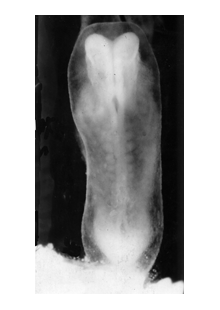The Stages of Human Embryonic Development
Stage 10 embryos have a greatest length of 1.5 to 3.6 mm and an estimated postfertilization age of 28 to 30 days. There are 4 to 12 pairs of somites along the body axis. The neural tube begins to form and has rostral and caudal neuropores. The five major subdivisions of the brain can be identified in the neural folds. The optic sulcus is present with a chiasmatic plate in the midline. The first pharyngeal pouch is close to the relatively large otic placode. Presumptive left and right atria and ventricles of the heart can be identified by their relative locations. The epimyocardium and the bulbotruncus region are present. The stomodeum, thyroid gland primordium, laryngotracheal sulcus and hepatic plate are all present. The nephrogenic cord or intermediate mesoderm can be identified lateral to the somites. There is no evidence of limb buds.
